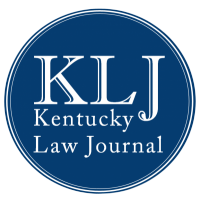Ames v. Ohio Department of Youth Services: The Likely End of the “Extra Burden” in Reverse Discrimination Claims
Blog Post | 113 KY. L. J. ONLINE | February 4, 2025
Ames v. Ohio Department of Youth Services: The Likely End of the “Extra Burden” in Reverse Discrimination Claims
By: Amanda Lindsey, Staff Editor, Vol. 113
Title VII of the Civil Rights Act of 1964 makes it unlawful for an employer to discriminate against individuals on the basis of their “race, color, religion, sex, or national origin.”[1] In employment discrimination claims, a plaintiff need only demonstrate that their protected characteristic was one of the motivating factors behind the employer’s decision.[2] Proving discrimination, however, can be challenging, particularly in the absence of direct evidence.[3] To ease this burden, the Supreme Court in McDonnell Douglas Corp. v. Green established the principal framework for evaluating circumstantial evidence when direct proof is unavailable.[4] Legal precedent consistently affirms that Title VII protects all individuals from discrimination, regardless of whether they belong to a majority or minority group.[5] Circuit courts, however, remain divided on whether plaintiffs from majority groups must meet an additional burden of proof in employment discrimination cases.[6] The Supreme Court will address this issue in an appeal from the Sixth Circuit,[7] a decision that will likely have significant implications for employment practices.
Marlean Ames worked for the Ohio Department of Youth Services beginning in 2004 and was promoted to the position of “PREA Administrator” in 2014.[8] In 2019, Ames applied for the Department’s “Bureau Chief of Quality” position.[9] Following her interview, her supervisor —who identified as gay — suggested that she consider retiring.[10] Ames was not selected for the position and was instead demoted, resulting in a reduction of her wages “from $47.22 per hour to $28.40.”[11] The Department subsequently replaced her with a younger, gay man and later filled the Bureau Chief role with a gay woman.[12]
Ames alleges that the Department discriminated against her because of her heterosexuality.[13] In the absence of direct evidence, the Sixth Circuit applied the McDonnell Douglas framework, which required Ames to establish the following elements: “(1) that she was a member of a protected class; (2) that she was subject to an adverse employment decision; (3) that she was qualified for the relevant position; (4) and that her employer treated more favorably a similarly qualified person who was not a member of the same protected class.”[14] The court found that Ames’s “prima-facie case was easy to make,” noting that sexual orientation is a protected characteristic under Title VII,[15] she was demoted despite receiving positive performance reviews, and she was replaced by a gay man, with the Bureau Chief position ultimately filled by a gay woman.[16] Because Ames’s heterosexuality was considered part of the “majority,” the court determined that she needed to prove additional evidence — referred to as “background circumstances” — to suggest that the employer was an atypical one that discriminates against majority group members.[17] This could be demonstrated by either showing that the decision was made by a member of the relevant minority group or by providing statistical evidence indicating a pattern of discrimination against the majority.[18] Ames failed to meet this burden, as the supervisors who officially demoted and replaced her were both heterosexual men, and her evidence was limited to her own claim of discrimination.[19]
Although the court ruled in favor of the Department, Judge Kethledge expressed concerns in a concurring opinion regarding the “background circumstances” test adopted by the majority.[20] He argued that the rule “is not a gloss upon the 1964 Act, but a deep scratch across its surface.”[21] Judge Kethledge criticized the test for failing to apply the Act’s protections equally, contrary to its explicit language and original intent.[22] Additionally, he noted the ongoing circuit split on this issue, with five circuits adopting the rule, while others have either rejected it or not applied it at all.[23]
The Supreme Court is likely to reject the “background circumstances” test in its forthcoming decision. The Court has previously emphasized that “[e]liminating racial discrimination means eliminating all of it,”[24] a principle that guided its rulings in two recent cases, Muldrow v. City of St. Louis[25] and Students for Fair Admission.[26] Additionally, both the EEOC and the DOJ filed amicus briefs in opposition of the test, arguing that the additional burden “frustrates Title VII’s purpose and contradicts court precedent.”[27]
If the test is rejected, it will be easier for majority group plaintiffs to pursue reverse discrimination claims within the circuits currently applying it.[28] While the Court will not address diversity, equity, and inclusion (DEI) programs directly in this case, challenges to these programs will likely rise,[29] as they are commonly a basis for reverse discrimination claims.[30] Accordingly, it is crucial for employers to review their current DEI and hiring policies to ensure that they are both legitimate and grounded in sound, well-reasoned employment practices.
[1] 42 U.S.C. § 2000e-2(a)(1) (2024).
[2] See Susan L. Nardone & Carla N. Dorsi, A Mixed Bag on Mixed-Motive Standard Needs Resolution, Metro. Corp. Couns., Nov. 2008, at 30.
[3] See Tom Spiggle, Winning An Employment Lawsuit Is Hard. What To Know About Evidence, Forbes (Jul. 7, 2022, 6:45 AM), https://www.forbes.com/sites/tomspiggle/2022/07/07/winning-an-employment-lawsuit-is-hard--what-to-know-about-evidence/.
[4] McDonnell Douglas Corp. v. Green, 411 U.S. 792, 802 (1973).
[5] See Susan C. Thies, Mills v. Health Care Service Corporation: Are “Background Circumstances” Too Much To Ask of a Plaintiff Alleging Reverse Discrimination in Employment?, 74 St. John’s L. Rev. 537, 538 n.3 (2000) (citing Supreme Court precedent that affirms that Title VII also applies to majority group individuals).
[6] Alicia Roberts Johnson, Jessica H. Thomas, & Amanda T. Quan, Supreme Court to Hear Heterosexual Woman’s Reverse Discrimination Case, Ogletree Deakins (Oct. 16, 2024), https://ogletree.com/insights-resources/blog-posts/supreme-court-to-hear-heterosexual-womans-reverse-discrimination-case/.
[7] Id.
[8] Ames v. Ohio Department of Youth Services, 87 F.4d 822, 824 (2023).
[9] Id.
[10] Id.
[11] Id.
[12] Id.
[13] Id.
[14] Id. (citing Jackson v. VHS Detroit Receiving Hosp., Inc., 814 F.3d 769, 776 (6th Cir. 2016)).
[15] Id. at 825 (citing Bostock v. Clayton County, 590 U.S. 644 (2020)).
[16] Id.
[17] Id.
[18] Id.
[19] Id.
[20] Id. at 827.
[21] Id.
[22] Id.
[23] Id.
[24] Charles M. Blow, The Supreme Court Didn’t Put Racism on a Leash. It Granted It License., N.Y. Times (Jul. 5, 2023), https://www.nytimes.com/2023/07/05/opinion/supreme-court-affirmative-action.html (citing Students for Fair Admissions, Inc. v. President & Fellows of Harvard College, 600 U.S. 181, 206 (2023)).
[25] Muldrow v. City of St. Louis, 144 S. Ct. 967, 976–-77 (2024) (holding that an adverse employment action does not need to be “significant” or “serious” to be actionable under Title VII, there must only be an injury that leaves the plaintiff “worse off”).
[26] Students for Fair Admissions, Inc. v. President & Fellows of Harvard College, 600 U.S. 181, 318 (2023) (holding that race-conscious admissions policies violated the Equal Protection Clause).
[27] Juan C. Enjamio & Veronica A. Torrejon, EEOC and DOJ Oppose Heightened Standard in “Reverse Discrimination” Cases, Hunton (Jan. 6, 2025), https://www.hunton.com/hunton-employment-labor-perspectives/eeoc-and-doj-oppose-heightened-standard-in-reverse-discrimination-cases.
[28] Alyesha Asghar & Julian G.G. Wolfson, High Court to Review Standard Applied to “Reverse Discrimination” Cases, Littler (Oct. 28, 2024), https://www.littler.com/publication-press/publication/high-court-review-standard-applied-reverse-discrimination-cases.
[29] Id.
[30] See Michelle Travis, The Supreme Court Case That Will Fuel The Corporate DEI Debate In 2025, Forbes (Dec. 22, 2024, 7:45 AM), https://www.forbes.com/sites/michelletravis/2024/12/22/the-supreme-court-case-that-will-fuel-the-corporate-dei-debate-in-2025/.

